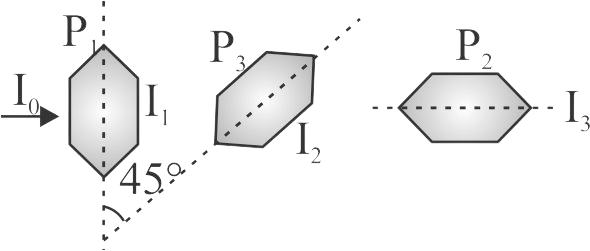367846 A horizontal beam of vertically polarized light of intensity \(43\;W{\rm{/}}{m^2}\) is sent through two polarizing sheets. The polarizing direction of the first is \(60^{\circ}\) to the vertical, and that of the second is horizontal. The intensity of the transmitted by the pair of sheets is (nearly)
367849 Two Polaroids \({P_1}\) and \({P_2}\) are placed with their axis perpendicular to each other. Unpolarised light \({I_0}\) is incident on \({P_1}\). A third polaroid \({P_3}\) is kept in between\({P_1}\) and \({P_2}\) such that its axis makes an angle \(45^\circ \) with that of \({P_1}\) .The intensity of transmitted light through \({P_2}\) is
367846 A horizontal beam of vertically polarized light of intensity \(43\;W{\rm{/}}{m^2}\) is sent through two polarizing sheets. The polarizing direction of the first is \(60^{\circ}\) to the vertical, and that of the second is horizontal. The intensity of the transmitted by the pair of sheets is (nearly)
367849 Two Polaroids \({P_1}\) and \({P_2}\) are placed with their axis perpendicular to each other. Unpolarised light \({I_0}\) is incident on \({P_1}\). A third polaroid \({P_3}\) is kept in between\({P_1}\) and \({P_2}\) such that its axis makes an angle \(45^\circ \) with that of \({P_1}\) .The intensity of transmitted light through \({P_2}\) is
367846 A horizontal beam of vertically polarized light of intensity \(43\;W{\rm{/}}{m^2}\) is sent through two polarizing sheets. The polarizing direction of the first is \(60^{\circ}\) to the vertical, and that of the second is horizontal. The intensity of the transmitted by the pair of sheets is (nearly)
367849 Two Polaroids \({P_1}\) and \({P_2}\) are placed with their axis perpendicular to each other. Unpolarised light \({I_0}\) is incident on \({P_1}\). A third polaroid \({P_3}\) is kept in between\({P_1}\) and \({P_2}\) such that its axis makes an angle \(45^\circ \) with that of \({P_1}\) .The intensity of transmitted light through \({P_2}\) is
367846 A horizontal beam of vertically polarized light of intensity \(43\;W{\rm{/}}{m^2}\) is sent through two polarizing sheets. The polarizing direction of the first is \(60^{\circ}\) to the vertical, and that of the second is horizontal. The intensity of the transmitted by the pair of sheets is (nearly)
367849 Two Polaroids \({P_1}\) and \({P_2}\) are placed with their axis perpendicular to each other. Unpolarised light \({I_0}\) is incident on \({P_1}\). A third polaroid \({P_3}\) is kept in between\({P_1}\) and \({P_2}\) such that its axis makes an angle \(45^\circ \) with that of \({P_1}\) .The intensity of transmitted light through \({P_2}\) is

